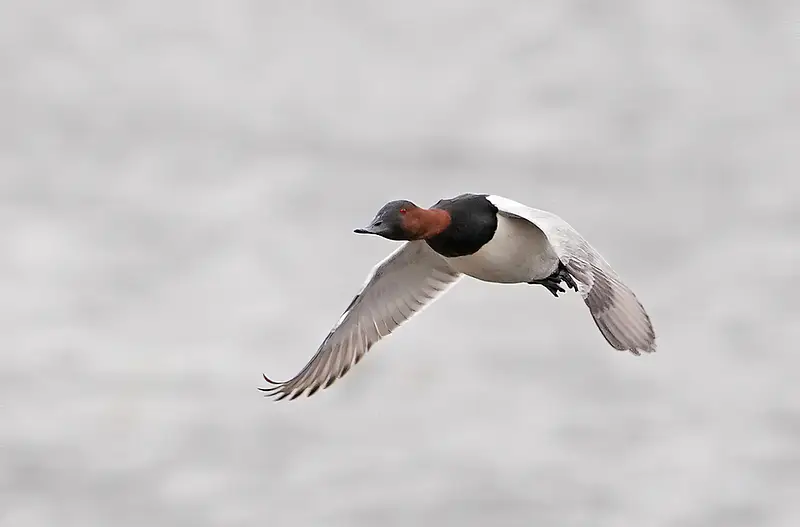About Canvasback
The Canvasback (Aythya valisineria) sometimes referred to as the “king of ducks,” is a large-bodied diving duck renowned for its elegant appearance and powerful diving abilities. With a wingspan of up to 35 inches and weighing between 2.5 to 3.5 pounds, they are among the largest of North American ducks. Canvasbacks are known for their distinctive rusty-red heads, bright red eyes, and long, sloping black bills. Males display a striking contrast with their black chests and white bodies, while females have a more subdued appearance with brownish heads and bodies.
These birds are notorious for nest parasitism, or egg dumping, where hen Canvasbacks will lay eggs in another hen’s nest, similar to the behavior of wood ducks. This strategy can increase their reproductive success by spreading their eggs across multiple nests.

Identification
Canvasbacks are easily identifiable by their long, sloping forehead and bill, creating a unique profile. Their distinctive rusty-red heads and bright red eyes make them stand out among other duck species. Males have a black chest and white body, while females are more brownish overall, with a slightly lighter head.
Breeding
Canvasbacks breed in the prairie pothole region and boreal forests, preferring wetlands with dense emergent vegetation for nesting. The female lays a clutch of around seven to ten eggs and incubates them alone while the male leaves to molt. Nest parasitism is common, with females often laying eggs in the nests of other Canvasbacks or other duck species, increasing the chances of their offspring surviving.
Behavior
Canvasbacks are social birds and often form large flocks during migration and wintering periods. As diving ducks, they are known for their ability to dive deep to forage for food, primarily aquatic plants, invertebrates, and small fish. They exhibit nest parasitism behavior, where females will lay eggs in the nests of other Canvasbacks or even other duck species, enhancing their reproductive success.
Habitat
During the breeding season, Canvasbacks are found in the prairie pothole region and boreal forests, favoring wetlands with dense emergent vegetation for nesting. In the winter, they migrate to large lakes, coastal bays, and estuaries where they can dive for food in deeper waters. Their preferred wintering habitats include the Chesapeake Bay, the Great Lakes, and the Gulf Coast, where they gather in large numbers to take advantage of abundant food resources
Migration
Canvasbacks are long-distance migrants that travel from their breeding grounds in the prairie pothole region and boreal forests of North America to wintering habitats along the coasts and large inland lakes. They migrate in large flocks and are often found along the Atlantic and Pacific Flyways during migration, with significant populations wintering in the Chesapeake Bay, the Great Lakes, and the Gulf Coast.
No Data Found
How many days tracked
Lorem ipsum dolor sit amet, consectetur adipiscing elit. Ut elit tellus, luctus nec ullamcorper mattis, pulvinar dapibus leo.
Where are they now?
Lorem ipsum dolor sit amet, consectetur adipiscing elit. Ut elit tellus, luctus nec ullamcorper mattis, pulvinar dapibus leo.
No Data Found
No Data Found
Total Number of Data Points for Canvasback
Lorem ipsum dolor sit amet, consectetur adipiscing elit. Ut elit tellus, luctus nec ullamcorper mattis, pulvinar dapibus leo.
Start and End Date Tracking of Canvasback
Lorem ipsum dolor sit amet, consectetur adipiscing elit. Ut elit tellus, luctus nec ullamcorper mattis, pulvinar dapibus leo.
No Data Found
Overall Data from the Center
This is historical data from various sources. This data is available in its full form on our Duck Map in an easily visualizable format.
